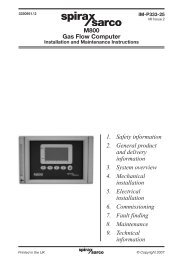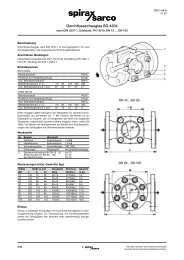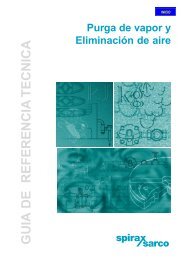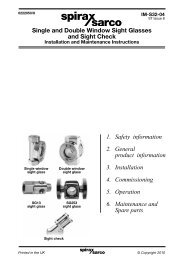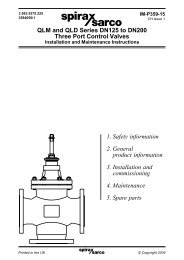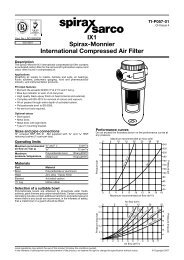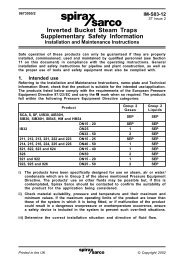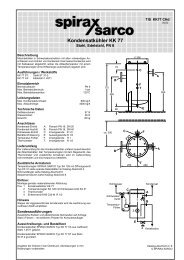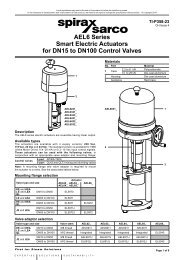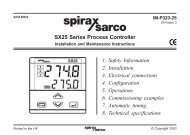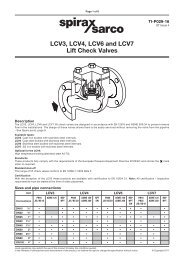2000 Hook-up Book - Spirax Sarco
2000 Hook-up Book - Spirax Sarco
2000 Hook-up Book - Spirax Sarco
Create successful ePaper yourself
Turn your PDF publications into a flip-book with our unique Google optimized e-Paper software.
SYSTEM DESIGN<br />
20<br />
Pressure Reducing Stations<br />
PRV Station Components<br />
A stop valve is usually needed so<br />
that the steam s<strong>up</strong>ply can be shut<br />
off when necessary, and this<br />
should be followed by a line size<br />
strainer. A fine mesh stainless<br />
steel screen in the strainer will<br />
catch the finer particles of dirt<br />
which pass freely through standard<br />
strainers. The strainer should<br />
be installed in the pipe on its side,<br />
rather than in the conventional<br />
way with the screen hanging<br />
below the pipe. This is to avoid the<br />
screen space acting as a collecting<br />
pocket for condensate, since<br />
when installed horizontally the<br />
strainer can be self-draining<br />
Remember that water which<br />
collects in the conventionally piped<br />
strainer at times when the reducing<br />
valve has closed, will be carried<br />
into the valve when it begins to<br />
open. This water, when forced<br />
between the valve disc and seat of<br />
the just-opening valve, can lead<br />
rapidly to wire-drawing, and the<br />
need for expensive replacements.<br />
Pressure gauges at each side<br />
of the reducing valve allow its performance<br />
to be monitored. At the<br />
reduced pressure side of the valve,<br />
a relief or safety valve may be<br />
required. If all the equipment connected<br />
on the low pressure side is<br />
capable of safely withstanding the<br />
<strong>up</strong>stream pressure in the event of<br />
reducing valve failure, the relief<br />
valve may not be needed. It may<br />
be called for if it is sought to protect<br />
material in process from overly<br />
high temperatures, and it is essential<br />
if any downstream equipment<br />
is designed for a pressure lower<br />
than the s<strong>up</strong>ply pressure.<br />
Steam Safety Valve Sizing<br />
When selecting a safety valve, the<br />
pressure at which it is to open<br />
must be decided. Opening pressure<br />
must be below the limitations<br />
of the downstream equipment yet<br />
far enough above the normal<br />
reduced pressure that minor fluctuations<br />
do not cause opening or<br />
dribbling. Type “UV” Safety Valves<br />
for unfired pressure vessels are<br />
tested to ASME Pressure Vessel<br />
Code, Section VIII and achieve<br />
rated capacity at an accumulated<br />
pressure 10% above the set-to-<br />
open pressure. Safety valves for<br />
use on boilers carry a “V” stamp<br />
and achieve rated capacity at only<br />
3% overpressure as required by<br />
Section I of the Code.<br />
The capacity of the safety<br />
valve must then equal or exceed<br />
the capacity of the pressure<br />
reducing valve, if it should fail<br />
open when discharging steam<br />
from the <strong>up</strong>stream pressure to the<br />
accumulated pressure at the safety<br />
valve. Any bypass line leakage<br />
must also be accounted for.<br />
Figure 37<br />
Typical Installation of Single Reducing Valve with Noise Diffuser<br />
Bypasses may be prohibited<br />
by local regulation or by<br />
insurance requirements<br />
Separator<br />
Figure 38<br />
Typical Installation<br />
of Two Reducing<br />
Valves in Parallel<br />
Trap Set<br />
Pressure<br />
Sensing Line<br />
Reducing<br />
Valve<br />
Diffuser<br />
Safety Valve<br />
Downstream Isolating Valve is<br />
needed only with an alternative<br />
steam s<strong>up</strong>ply into the L.P. System<br />
Figure 39<br />
Two-Stage Pressure Reducing Valve Station<br />
with Bypass Arrangement to Operate Either<br />
Valve Independently on Emergency Basis



